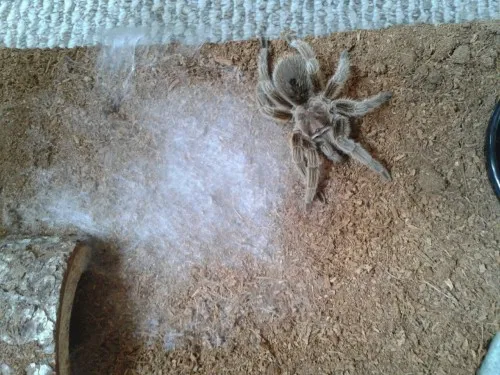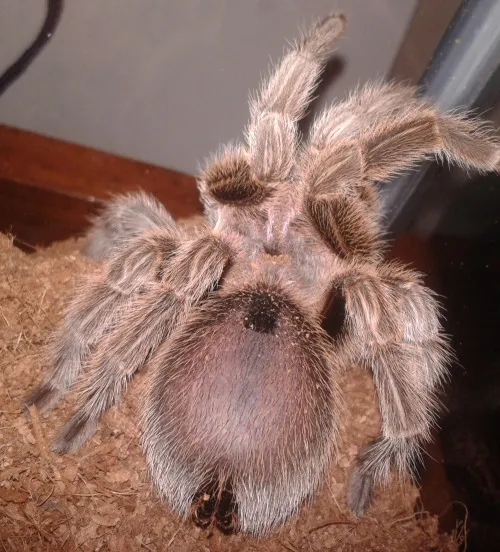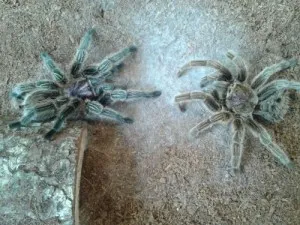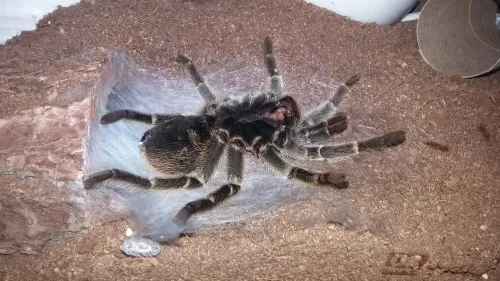What is Premolt in Tarantulas?
Premolt is a critical phase in a tarantula’s life cycle, the period leading up to molting. Molting is the process where a tarantula sheds its exoskeleton, which is essentially its outer skeleton, to allow for growth. As tarantulas grow, their current exoskeleton becomes too small, necessitating this process. During premolt, the tarantula undergoes significant internal and external changes as it prepares for this demanding event. Understanding the signs of premolt is crucial for any tarantula keeper, as it allows you to provide the necessary care and ensure the well-being of your pet during this vulnerable time. Recognizing these signs can help prevent unnecessary stress and potentially save a tarantula’s life. Being prepared for premolt involves adjusting the environment and avoiding any disturbances that could interfere with the molting process. The more familiar you are with the signs, the better equipped you will be to support your tarantula through this natural and essential part of its life.
Signs of Premolt A Behavioral Shift
Behavioral changes are often the first indicators that your tarantula is entering premolt. These changes can be subtle at first but become more pronounced as the molt approaches. Paying close attention to your tarantula’s daily habits can help you identify these early warning signs, allowing you to adjust their care accordingly. These shifts in behavior are a direct result of the physiological changes happening within the tarantula’s body, preparing it for the arduous process of shedding its exoskeleton. Recognizing and understanding these behavioral changes is the initial step in ensuring a smooth and safe molting experience for your tarantula. By observing your tarantula closely, you can provide the necessary support and create a stress-free environment during this critical period, contributing significantly to its overall health and well-being.
Reduced Appetite

One of the most common signs of premolt is a significant decrease in appetite. Your tarantula may refuse food altogether, even if it’s a favorite meal. This behavior is a clear indication that the molting process is imminent. The tarantula’s body is preparing for the molt by conserving energy and resources. The spider will stop eating weeks or even months before the molt. This is a natural behavior, and it’s important not to force-feed your tarantula. Trying to feed your tarantula during this time can cause undue stress and may even lead to injury. Reduce feeding frequency or stop feeding entirely. This shift in appetite is a natural part of the process, and as long as your tarantula is otherwise healthy, there’s no cause for concern. This allows the tarantula to focus its energy on the internal changes required for molting, making the entire process more efficient and less stressful.
Lethargy and Hiding
Tarantulas in premolt often become lethargic and spend more time hiding. They may retreat to their burrow or a secluded area of their enclosure, avoiding interaction. This behavior is a protective measure, as they become more vulnerable during this period. The spider will appear less active than usual, moving slowly and often remaining still for extended periods. It’s essential not to disturb your tarantula when it’s hiding, as this can cause unnecessary stress. Provide a safe and quiet environment to allow the tarantula to feel secure and prepare for the molt without interruption. This withdrawal is a sign that the tarantula is focusing its energy internally, preparing for the demanding process of shedding its exoskeleton. Make sure the enclosure is well-ventilated and at the correct temperature to further support the tarantula’s health.
Darkening Abdomen
As the molt approaches, the abdomen of your tarantula may appear darker than usual. This is due to the new exoskeleton forming beneath the old one, causing a darkening of the underlying tissue. The darkening is particularly noticeable in species with lighter-colored abdomens. The change in color can be a subtle yet reliable indicator that the molting process is underway. This darkening is caused by the buildup of fluids and the formation of the new exoskeleton underneath the old one. This is a normal physiological change, and it’s an indication that your tarantula is getting ready to shed its outer layer. Observe carefully to spot the change. You may also notice the abdomen becoming slightly swollen or plump.
Bald Spot (Exposed Skin)

A bald spot or area of exposed skin on the abdomen is another significant sign of premolt, especially in older tarantulas or those that have undergone several molts. This bald spot is where the urticating hairs, used for defense, have been worn away. This area is where the new exoskeleton will emerge during the molt. The appearance of a bald spot is a clear indication that the tarantula is nearing the molting stage, the new skin is visible, and the old exoskeleton is ready to be shed. A bald spot on the abdomen is a clear visual signal of the impending molt. This spot is actually the area where the new exoskeleton is forming, which is visible through the old one. The spider’s body is preparing for the molt, and this physical change is a key indicator.
Signs of Premolt Physical Changes
In addition to behavioral changes, there are several physical signs that indicate your tarantula is in premolt. These physical changes are often more definitive indicators, confirming that the molting process is imminent. Paying attention to these signs will help you prepare appropriately and provide optimal care during this critical period. These visual cues are a direct result of the physiological changes that are taking place within the tarantula’s body, preparing it for the complex process of shedding its old exoskeleton. By recognizing these physical changes, you can ensure that you are doing everything possible to support your tarantula through this natural and necessary process.
Color Changes
The overall coloration of your tarantula may change during premolt. The colors may appear duller or faded, or in some cases, the tarantula may appear darker. The changes are caused by the new exoskeleton forming underneath the old one, and the old exoskeleton starts to separate from the underlying tissues. These color changes can vary depending on the species, but they are generally noticeable. This change can be a subtle but telling sign that the molting process is approaching. The colors may appear less vibrant as the new exoskeleton forms beneath the old, preparing to replace it. The changes in coloration are a visual cue that the tarantula is gearing up for the molt. Note these changes in coloration and any other physical changes.
Increased Weight (Plumpness)

Many tarantulas will appear plumper or more bloated during premolt. This is because they are storing fluids between the old and new exoskeletons, which aids in the molting process. The spider absorbs a lot of water to separate the old exoskeleton. You may notice that the abdomen appears more rounded than usual, and the tarantula may feel heavier. This increase in weight is a sign that the tarantula is preparing to shed its exoskeleton. Keep in mind this can vary among different species. This is a natural process and not a cause for alarm. The fluids help the tarantula to split its old exoskeleton more easily and to expand its body as it emerges from the old shell. Make sure to avoid handling the tarantula during this time as it may be more fragile and vulnerable.
Preparing for the Molt Providing the Right Environment
Creating the right environment is crucial during premolt to help your tarantula molt successfully. The key aspects to consider are humidity, temperature, and minimizing disturbances. By paying attention to these factors, you can significantly increase the chances of a healthy molt and support your tarantula during this vulnerable time. Providing the correct environment reduces stress, which is essential for the tarantula’s well-being during the molting process. Make sure the enclosure is secure and free from potential hazards. The right conditions will make the process smooth and safe. Ensuring the enclosure is set up correctly and that the tarantula feels safe will aid the process.
Humidity and Temperature
Maintain the appropriate humidity and temperature levels for your tarantula species during premolt. High humidity can help the old exoskeleton to split more easily. While the exact humidity level will vary depending on the species, it’s important to ensure the enclosure is not too dry. Monitoring the temperature is also important. The temperature should be within the recommended range for your tarantula species, as this can affect the molting process. Use a hygrometer to monitor humidity levels, and adjust as needed by misting the enclosure lightly. You can provide a shallow water dish and ensure proper ventilation to maintain ideal conditions. Maintaining the proper environment is critical for ensuring a successful molt. Be sure to research the specific needs of your tarantula species and adjust the conditions accordingly. This helps them split the exoskeleton.
Avoiding Disturbances

Minimize any disturbances to your tarantula during premolt. Avoid handling your tarantula, as this can stress it out and potentially interfere with the molting process. Keep the enclosure in a quiet area, away from excessive noise or movement. Reduce any potential stressors, such as loud noises or sudden vibrations. The goal is to make the tarantula feel as safe and secure as possible. If you need to clean the enclosure, do so gently and avoid disturbing the tarantula. Avoid vibrations and sudden movements around the enclosure. Allowing your tarantula to molt undisturbed can help it successfully shed its old exoskeleton. Giving the tarantula space and privacy can aid the process, giving the spider time to molt without being disturbed.
What to Do During Premolt and Molting
Knowing how to respond during the premolt and molting phases is essential for ensuring the health and safety of your tarantula. There are several actions you should take, as well as precautions to keep in mind. By providing the appropriate care, you can help your tarantula through this delicate process and reduce the risk of complications. This period is crucial for the tarantula’s growth and development, and your actions can significantly impact its overall well-being. By understanding the do’s and don’ts, you can significantly contribute to the tarantula’s health and help them through a healthy molt. It is important to be prepared and informed, allowing you to provide the best possible care. Be aware of the signs and what actions you need to take to assist the tarantula during this important phase.
Do not Feed
Do not feed your tarantula once it has shown signs of premolt, especially if it’s refusing food. Feeding a tarantula that is preparing to molt can cause it unnecessary stress and may lead to the tarantula to reject the meal. In most cases, the tarantula will refuse food, and the refusal is an indicator that it is readying itself to molt. Trying to force-feed a tarantula during this stage can be harmful. Allow your tarantula to rest and conserve energy. Instead, make sure fresh water is available at all times. Your tarantula’s focus is on the molting process and is not interested in food. It’s crucial not to interfere with the natural molting process. If the tarantula is eating, it is most likely not in premolt, but if it has stopped eating or refuses food, it is likely in premolt.
Provide a Safe Space

Make sure your tarantula has a safe and secure space to molt. Provide plenty of substrate for burrowing species, as they often molt in their burrows. Avoid disturbing the tarantula during the molting process. Ensure the enclosure is free from any hazards, such as sharp objects or potential fall risks. Reduce any stress factors to allow the tarantula to molt undisturbed. You can also add a hide to the enclosure. Providing a safe space ensures the tarantula feels secure and reduces stress, which can contribute to a successful molt. Minimize disturbances and let the tarantula be. This is an important aspect that ensures the molting process runs smoothly, so the tarantula can shed its exoskeleton easily. A safe and secure environment is paramount during molting, which protects your tarantula from unnecessary stress and potential harm.
Post-Molt Care
After your tarantula has molted, there are a few things to keep in mind to ensure a smooth transition. The new exoskeleton is soft and vulnerable immediately after molting. Providing the right post-molt care helps your tarantula to recover and regain its strength. These care tips will ensure the tarantula’s health after molting. The post-molt phase is as important as the premolt and molting phases. Post-molt care includes time to harden its new exoskeleton, rehydrate, and feed. Knowing these steps will ensure the tarantula’s health. Do not rush this stage as it will benefit the tarantula, allowing it to recover. Taking the appropriate measures during the post-molt phase will promote your tarantula’s overall health and well-being.
Hydration is Key
After molting, ensure your tarantula has access to fresh water. Molting can be a dehydrating process, so it’s important to help your tarantula rehydrate. Keep the water dish full and easily accessible. You can mist the enclosure lightly to provide additional moisture, but ensure proper ventilation to prevent mold growth. Rehydration is crucial for your tarantula’s health. Rehydrating will replenish the fluids lost during the molting process, preventing dehydration. Water is the key to your tarantula’s recovery after the molt. Make sure you provide fresh, clean water, which is critical for your tarantula’s recovery and long-term health. Hydration is the best way to support your tarantula after molting.
